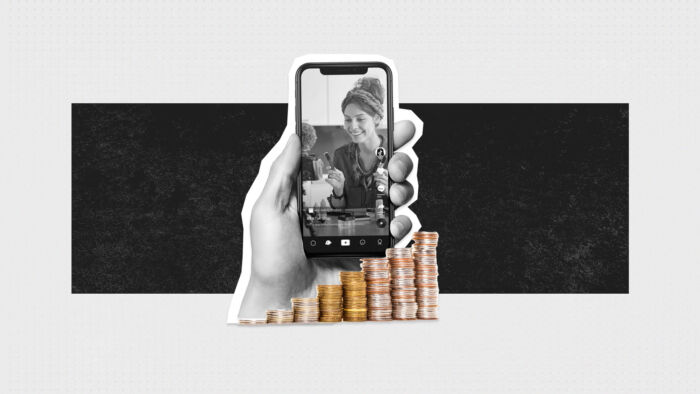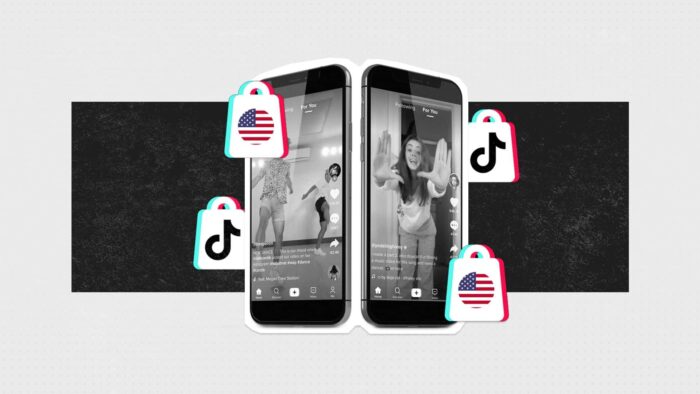In 2023, Global influencer spend hit an incredible $21 billion, up 29% from 2022. The channel has evolved from a PR bolt-on or campaign “nice to have”, to one of the decade’s most powerful media channels.
Despite this, some brands are still hesitant to invest significant budget in influencer, continuing to prefer tried and tested traditional channels like TV, OOH and Search.
In this blog, we’re exploring the benefits of influencer marketing in 2024, why the channel is an essential investment for brands, and how to get the most out of it.

What is influencer marketing?
Influencer marketing is a strategic collaboration between a business or brand and a person of “influence”. In many ways, we’re being influenced all the time, and the art of influencer marketing is just from brands harnessing this influence in effective ways.
In recent years though, influencer marketing has become synonymous with social media and creators. Increasingly data-driven, brands can collaborate with influencers on different platforms to tap into their followers with relevant content. Often these followers are highly engaged, so it’s a hugely effective way of driving awareness, engagement and consideration in a human way.
As we at Goat like to say, it’s all about niche content, to niche audiences, at scale.
How many brands use influencer marketing?
In 2023, 89% of marketers using influencer marketing said they were planning to increase or maintain their investments in it.
Where influencer was once a supplement to other digital channels, it’s now assuming a larger portion of some brand’s media spend. As of 2022, 39% of marketers invested 10 to 20 percent of their marketing budget into influencer marketing. A year later these investments had increased, with 23% investing up to 40 percent of their marketing spend into influencer marketing.
Influencer marketing has emerged as a pivotal element in marketing today, delivering tangible business outcomes for brands across multiple markets, from fast-food and fashion to hardware and B2B.
5 reasons why brands should invest in influencer marketing
Influencer is reaching maturity, and has emerged as a potent marketing tool for brands across multiple industries. Here are our top 5 benefits of influencer marketing:
1. People hate ads, but they love influencer content
Advertisers face a harrowing problem. Research shows that 99% of Gen Z will skip ads if that option is available. Another survey showed that 70% of people find digital advertising annoying and unpleasant, and 72% say that bad ad experiences had a negative impact on their perception of the brand.
Fortunately, there’s a solution. Ads manufactured using influencer content help brands navigate this tricky landscape. Ad creatives made by creators not only tend to feel more authentic and native to their respective platforms, but they also have the added benefit of a peer-to-peer recommendation. This is because people don’t feel as though they’re receiving an ad for a product. If an ad features a creator they recognize and trust, then the impact is much stronger.
The data weighs heavily in favor of influencer recommendations and endorsements too. 69% of consumers trust influencers, friends and family over information coming directly from a brand. Influencer-led ads often have a greater impact on purchasing decisions, as Pew Research suggests 4 out of 10 people’s buying decisions are influenced by content creators.
2. It drives results across the funnel
One of the many benefits of influencer marketing is that Influencers can help brands achieve some pretty impressive results, at every stage of the funnel. Here’s how:
Influencers are experts at building trust with their audience. The data is there to back it. 61% of consumers trust influencer recommendations, compared to 38% who trust brand-led content. By injecting influencer into full funnel strategies, brands can earn more consumer trust at every level.
Creators also help brands connect with hyper-targeted audiences at specific stages of awareness. This means brands can use influencers to plug the holes in their outreach, building a full-funnel campaign that drives results at each stage.
Brands can also maximize ROI by measuring their full-funnel results. For example, if you build a winning brand awareness campaign with proven results, you can assess the most engaged creators and work with them on consideration phase campaigns.
Creators integrate pretty seamlessly at every stage of the funnel, and have a track record of delivering results at every stage.
3. Creators can provide a voice for your brand
Audiences on social are accustomed to the creative sway of influencer content. People are much more interested in creators than they are brands. Partnering with influencers helps brands to personify, it can give brands a voice.
Take our work with Odeon for example. #FeelsGoodToFeel brought the sensory experience of cinema to life through influencers. We enlisted creators like Max Balegde to hero the campaign, creating a hilarious “Bottom of the Popcorn Lobby Chat” interview with cinema-goers, hosted on Odeon’s TikTok channel.
Not only did we educate, entertain, and excite our audience, we gave Odeon a voice in which they could resonate, and foster a deeper connection with their audience. Positioning Max on the brand’s channel helped to personify Odeon’s campaign, more so than opting solely for brand-led content.
4. You can reach previously untapped audiences
Think of influencers as a means of connecting the dots. Are you trying to plug into a new market, or looking to reach a younger demographic? Influencers will help you bridge the gap.
Brands have long been using creators to diversify the territories they operate in, and the audiences they target. Let’s look at Estee Lauder. A lot has changed in the world since the luxury beauty brand was formed in 1948, yet the core values it embodies are more relevant and more inspiring to women of all generations than ever before. To resonate with a younger audience, Estee Lauder took the step into TikTok, partnering with beauty influencers like Wendyskin, and graces.faces, to introduce their rich tapestry of Gen Z viewers to the luxury of Estee Lauder.
5. It can be integrated with other digital channels
Influencer marketing is symbiotic; integrating influencers into other digital channels works seamlessly, and is often a greater solution than brand-led marketing. As a matter of a fact, 92% of people trust influencers more than any advertisement or traditional celebrity endorsement.
Perhaps the most exciting aspect of these integrations is the fact that influencer marketing aligns well with innovative channels, such as retail media and social commerce.
Influencer-led retail media
In the next 5 years, influencer-driven retail media is set to be a potent conversion driver. Repurposing influencer content as ads, it diverges from traditional social platforms, residing on retailer websites. This enables highly targeted ads, built upon consumer shopping behavior data. Brands can strategically place ads where their audience is most active, increasing the likelihood of direct clicks to the retailer site for purchases. This innovative approach optimizes conversions by aligning content with audience habits and preferences.
While this formula is not yet widely available, The Goat Agency has pioneered a groundbreaking collaboration with Amazon Ads. We have introduced influencer-led shoppable content to Amazon’s advertising services. As the sole agency globally with this capability, we enable brands to reach and reconnect with customers across the web and Amazon.com. Our unique approach preserves the visual and experiential qualities of social media posts, seamlessly guiding users to products on Amazon for an enhanced shopping experience.
Influencer-led social commerce
The combination of social media and e-commerce has given shoppers a way to purchase directly through social media networks. With social commerce, the entire shopping experience, from product discovery and research, right through to check out, all takes place in-app.
Social commerce is on the rise and is anticipated to have its most significant growth in 2024. In the US, around 36% of internet users, approximately 90.2 million people, engage in social commerce. Notably, TikTok Shop is a major development, allowing users in select countries, including the US and the UK, to discover and purchase items directly in-app. As of late 2023, eMarketer estimated that 33.3 million US social buyers would utilize TikTok for in-app purchases. TikTok Shop is gearing up to add to the benefits of influencer marketing in 2024, stay tuned.
Influencer marketing offers a huge boost to social commerce strategies. Not only do they help brands build a more credible strategy, they drive multi-purpose content, and greater targeting, too. It’s not a surprise then that brands are already jumping on the social commerce trend, using influencers to sell products directly within social media apps.
Investing in influencer marketing could help you tap into the latest innovations in digital marketing, and get a step ahead of the competition.

5 influencer marketing tips for 2024
Having a plan that maximizes your investment in influencer marketing is crucial. Here’s how you can make the most of your marketing spend, while preventing the costliest errors:
(1/5) Take things omnichannel
In retail, the lines between online and offline shopping continue to blur, which has enabled influencer marketing to take a considerable foothold in omnichannel marketing. For brands, harnessing the persuasive power of influencers has offered an opportunity to bridge the gap between online and offline channels, delivering a consistent brand experience both on and off the social feed.
Brands can combine influencer marketing with omnichannel in a number of ways.
1. Real-time collaboration
Live collaborations with influencers enhance a brand’s omnichannel marketing by creating real-time engagement across various channels. These interactions foster immediacy, authenticity, and viewer participation, resulting in a unified and memorable customer experience. Take inspiration from beauty brand, Sephora, whose live collabs with influencers are extended to live broadcasts across the brand’s website, social channels, and brick and mortar stores, where viewers can tune in to see product reviews, makeup tutorials, and more.
2. Leverage brand ambassadors
Influencer ambassadors maintain a consistent brand message across multiple platforms, from social media to in-store appearances. Their ongoing support fosters trust and loyalty among their dedicated followers, contributing to brand image and outreach. This integrated approach ensures a unified customer experience, aligning with the brand’s values and identity, and facilitates a seamless transition between online and offline channels.
3. Pop-up shop collaborations
Influencers can draw their online followers to physical stores, enhancing foot traffic and sales. Simultaneously, they document the in-store experience on their social channels, connecting with their online audience and promoting the brand. This bridge between digital and physical creates a unified customer journey that reinforces brand identity, and expands the brand’s reach effectively.
(2/5) Partner with influencers that fit your brand
We’re always saying this. Partner with the right influencers! This is not a one-size fits all industry, so if you want the most out of the benefits of influencer marketing, get those partnerships right. Brands often mistake an influencer’s size for their level of influence. Sure, Cristiano Ronaldo is the most followed person on Instagram with upwards of 618 million followers, but do his Binance endorsements make you want to invest in cryptocurrency? Absolutely not. Every influencer has a niche or passion point that they’ve built a following around, look to partner with one that fits your brand’s narrative.
Choosing quality engagement with a niche audience often outperforms more significant followings with minimal interaction. There’s also the debate between micro, macro, and hero influencers, and their respective levels of effectiveness.
(3/5) Authenticity is everything
Last year we saw a rising trend in influencers recommending the products not to buy, primarily across TikTok. A year on from ‘de-influencing’, it is more imperative than ever that brands strive for authenticity in influencer marketing.
Consumers need influencer marketing to be authentic because they want to trust the recommendations and opinions of the influencers they follow. Influencers have become a popular source of information and inspiration for many consumers, particularly younger demographics. When influencer marketing is not authentic, it can erode the trust that consumers have in both the influencer and the brand. Consumers today are increasingly skeptical of traditional advertising and are looking for genuine, honest recommendations from people they trust.
(4/5) Stay on top of social commerce innovations
Social commerce, and TikTok Shop in particular, are expected to take off in 2024. B2C brands should start looking at these channels, and how they can prepare a seamless shopping experience for customers who look to purchase directly within social apps.
In today’s social economy, influencer advocacy is viewed in the same breath as peer recommendations. 61% of consumers put their trust in influencer recommendations when considering a product. Influencers were the first to leverage social commerce, and have been helping brands immerse in the space since it launched in the West.
The rise of social commerce promises a more personalized, interactive, and boundary-blurring shopping experience that reshapes consumer habits and redefines the digital retail landscape. Influencers could be your route in.
(5/5) Talk to us about Amazon Ads retail media offering
Retail Media Networks (RMNs) have emerged as a powerful marketing tool and retailers such as Amazon, Walmart, Sainsbury’s among others are tapping into the movement. These platforms allow brands to run ads on retailer websites, as well as third party sites, directing customers back to the point of purchase.
We are the first influencer marketing agency to connect influencer and retail media channels, creating a powerful commerce-led solution.
Right now, we’re the only agency in the world capable of pushing influencer content across Amazon’s ad suite, whilst protecting the look and feel of influencer posts.
In essence, we can help brands target and retarget audiences across the web and on Amazon.com with influencer content. We can then drive customers to relevant products on Amazon, up to the point of purchase.
The value of the retail media industry sits at roughly £60bn. Of that £60bn figure, roughly £53bn is accounted for advertising activity on Amazon’s platforms. Now is the time to step into influencer-led retail media.
Why investing in influencer marketing is essential in 2024
The influencer marketing industry has reached maturity. No longer just considered a supplement it’s now a core media channel driving results at every stage of the funnel.
The success of influencer marketing on its own is unprecedented, but its capability to integrate with other channels takes things to another level. The worldwide value of social commerce is $724 billion, and of retail media it’s $60 billion. That’s $784 billion across two sectors that aren’t fully developed, and seamlessly integrate with influencer marketing.
These digital channels are set to revolutionize, not just influencer marketing, but the advertising infrastructure across the world. And, influencers are your ticket to leveraging these channels. If you want the maximize the benefits of influencer marketing, come talk to us.
—
Are you a B2C brand looking to learn more about retail media and how to leverage Amazon influencer marketing? Get in touch with us today to find out more.





